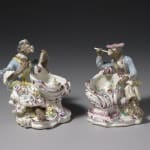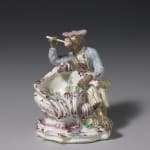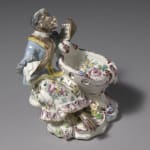


Pair of Bow Singerie Monkey Sweetmeat Dishes, Circa 1758-59
Further images
An extremely rare and highly important Pair of Bow Monkey, Singerie Sweetmeat Dishes, each rococo scrolled and shell formed, pierced sweatmeat dish supported on an irregular asymmetric scrolled base, edged in puce with blue and gold highlights, the interiors painted with brightly coloured sprays of European flowers, including honeysuckle, roses and plantagenista. One with a female monkey seated to one side, singing, one hand clutching a song sheet and the other clasped to her breast, wearing yellow edged blue frilled drapery and a floral skirt, with puce rose detail to the hem. The other with a male monkey blowing a flute like instrument, wearing a puce tricorn hat, knotted cravat, a yellow lined blue coat and striped pantaloons, his white waistcoat painted with puce roses. Each group applied at the base with brightly coloured flowers and leaves.
The modelling of Monkey or Singerie subjects was extremely popular during the rococo period as a conceit within the ideal of man’s triumph over nature, J.J.Kaendler having created the Monkey band figures at Meissen during the early 1750’s. The Meissen Monkey band figures, which created a proliferation of Singerie popular models were taken from engravings after drawings by Christophe Huet, who based them on his Singerie paintings at Chantilly, the home of the Prince de Conde. It is interesting to note that Madame de Pompadour owned examples of the Meissen figures.
For a similar pair of these very rare models, see Anton Gabszewicz ‘Bow Porcelain’ The collection of Geoffrey Freeman, no. 254. The female of the Freeman examples bears an incised T mark thus suggesting the work of the modeller John Toulouse.
See also Peter Bradshaw, Bow Porcelain Figures 1748-1774, pl. 175, no. B139. The colouring of the puce and blue scrolls forming the sweetmeat dishes should be compared to the Handel Clock Case, also within the Geoffrey Freeman collection, pl. 139 which bears the inscription and date ‘Fr. Nov. 5. 1759’, another of these Handel Clock Cases within the Cecil Higgins Museum, Bedford. Also compare the combination scroll colours with that of the scroll moulded Coffee Pot and cover with Bird spout in the Shreiber Collection at the Victoria and Albert Museum.
Join our mailing list
* denotes required fields
We will process the personal data you have supplied in accordance with our privacy policy (available on request). You can unsubscribe or change your preferences at any time by clicking the link in our emails.


